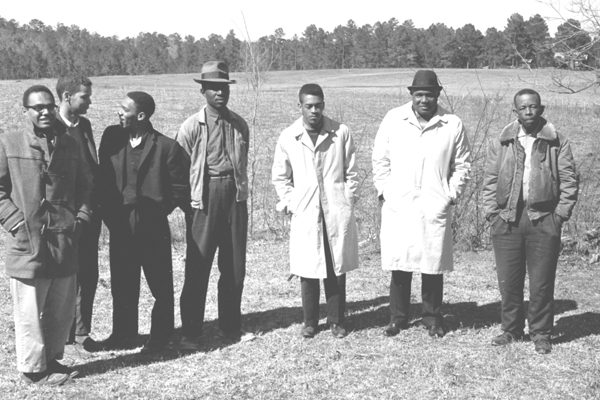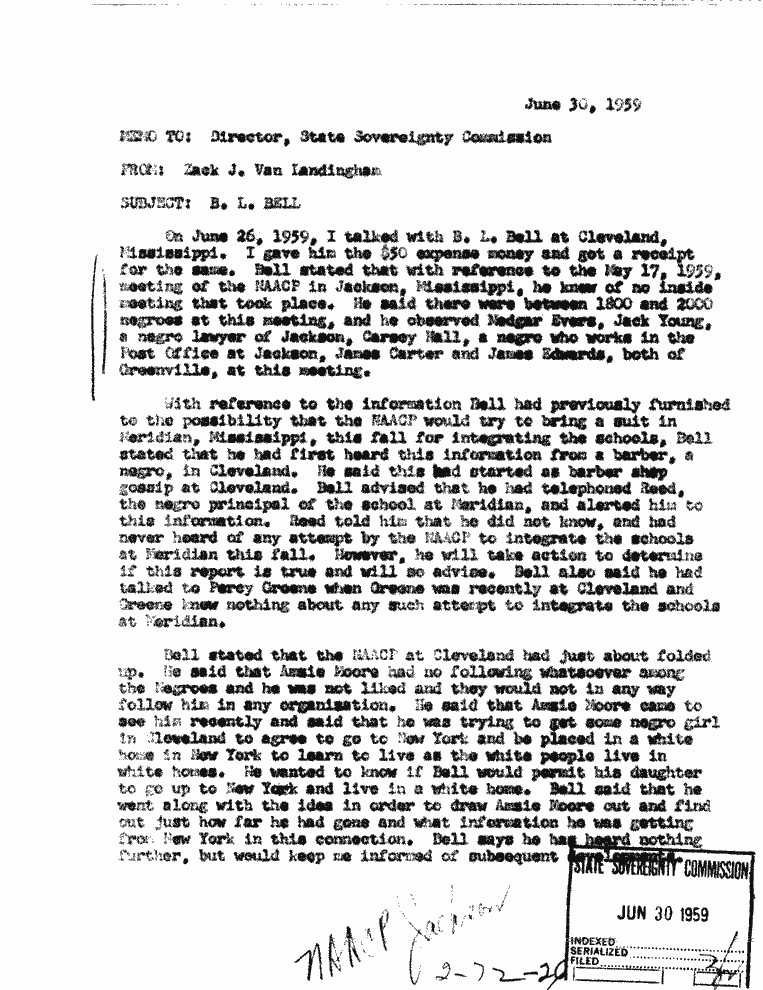Amzie Moore
September 23, 1911 – February 1, 1982
Raised in Grenada County, Mississippi
Amzie Moore brought SNCC into Mississippi; in fact, he put voter registration on SNCC’s table. As Bob Moses who first met Moore during a 1960 Mississippi trip remembered years later, “Amzie was the only one I met on that trip giving the student sit-in movement careful attention, aware of all that student energy and trying to figure out how to use it.”
Moore was born on September 23, 1911, in Grenada County, Mississippi. The family sharecropped and grew vegetables to stretch their furnish–the ten dollars a month they borrowed from the landlord to live on. His mother died when he was fourteen-years-old, leaving him to fend for himself. He went as far as the tenth grade in school–the highest grade offered at his high school. He started working at the post office in 1935 and used his solid income to build a house, becoming the first Black person in Bolivar County to receive a federal home loan.
In 1942, Amzie Moore was drafted in the U.S. military and that opened his eyes. Growing up in the South, he had believed that Black subjugation was God’s will. “I think what God did with me […] was put me on a ship and send me around the world,” Moore reasoned, “And let me live in different environments and be in contact with different people and to really and truly find out what was behind it because I certainly didn’t know.” After what Moore remembered precisely as “three years, six months, and eighteen days” of service, he returned to Mississippi enlightened with new understanding and commitment. His time in the service had taught him that “people are just people.”
Witnessing firsthand that Blacks were in no way innately inferior and now able to imagine worlds of possibility, Moore went to work challenging the racial order of the South. He helped found the Regional Council of Negro Leadership in 1951 and became president of the local branch of the NAACP. In 1954, he opened a combination service-station and cafe in Cleveland. “When I got through with it, people came; white people, black people, everybody came,” he remembered. For refusing to put a “colored only” sign up, local whites cut off his access to credit. He kept his brick home well-armed and at night, brightly lit with floodlights.
In their time together, Moore introduced Bob Moses to the idea and importance of organizing for voting rights. He had been making plans to fight to gain these rights for years. In the fall of 1960, Moore made his way to SNCC’s second conference being held in Atlanta. There he invited SNCC to join his efforts at voter registration in Mississippi, promising to support SNCC workers who came to Mississippi.
Moore taught the SNCC field workers what they could not learn at their universities or workshops: how to move in, out, and around rural communities effectively. He plugged organizers into his network. In 1962, Moore took Bob Moses and Dorie Ladner over to Charleston, Mississippi to recruit Willie Peacock, a student at Rust College to join SNCC’s voter registration drive. Moore and Peacock’s father both belonged to the Prince Hall Masons, and “my father was pretty happy about it,” Peacock remembered. “They were Master Masons and they were giving signs, and they were […] just having a good time about it.” Moore got SNCC workers Charles McLaurin, Charlie Cobb, and Landy McNair, started with their voter registration project by introducing them at a Ruleville church service one Sunday morning in 1962. Deepening these networks, the SNCC workers trudged up and down dirt roads, sat on porches, went to church, walked into cotton fields,and helped with daily chores.
Moore looked to SNCC’s young field staff with admiration, “I found that SNCC was for business, live or die, sink or swim, survive or perish. They were moving, and nobody seemed to worry about whether he was gonna live or die.”
Sources
Charles E. Cobb, Jr., This Nonviolent Stuff’ll Get You Killed: How Guns Made the Civil Rights Movement Possible (New York: Basic Books, 2014).
John Dittmer, Local People: The Struggle for Civil Rights in Mississippi (Urbana: University of Illinois Press, 1994).
Charles Payne, I’ve Got the Light of Freedom: The Organizing Tradition and the Mississippi Freedom Struggle (Berkeley: University of California Press, 1995).
Howell Raines, My Soul is Rested: Movement Days in the Deep South Remembered (New York: Putnam, 1977).
Interview with Amzie Moore by Michael Garvey, March 29 & April 13, 1977, Center for Oral History and Cultural Heritage, University of Southern Mississippi.
Interview with Wazir (Willie) Peacock by Bruce Hartford, July 2001, Civil Rights Movement Veterans Website.






